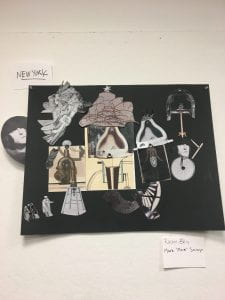

Month: October 2017
Fool The Hangman
Rule:
Need two or more players to play this game.
- One player will think of a word and represent it as a row of dashes. Let’s call this person the hangman or the drawing player.
- Other players need to guess what the word is by suggesting letters, but when these players have guessed the word they don’t speak out the word, since they want to fool the hangman in this game. Let’s call these people guessing players.
- When guessing players suggest the correct letter, the drawing players should write it on correct position.
- When guessing players suggest the wrong letter, the drawing player draw one element of a stick figure.
- Once drawing player finish the body of the stick figure, the game is not over. Instead of executing the stick figure, guessing player can still guess the word. At this time, if guessing player suggest the wrong letter, they can ask drawing player to draw an element of body to decorate the stick figure. Guessing players cannot ask drawing player to draw multiple repeated parts, like to draw boots on the sneakers.
- The game will be ended when: 1) The drawing does not match the description from guessing players. The drawing player loses and asks to tells the true answer. 2) The drawing player can give up when he feels like everyone knows the word (being “fooled” by everyone). Then he will ask or tell the true answer.
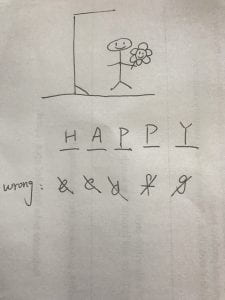
The first version of the game.
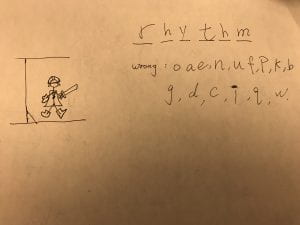
The second version of the game.
 The final play test on the class.
The final play test on the class.
Overview:
This game is called Fool the Hangman, and it is basically appropriated from the Hangman game. Originally, this game will end when the drawing player finish the stick figure before the guessing players guess out the word. Therefore, it is very easy for the drawing player to think of a really tricky word to fool the guessing player and execute the stick figure. The goal of my game inverses the situation that allows guessing players to fool the drawing player. After the drawing player finish the stick figure, guessing players still have chances to guess the word as many times as they want. Every time guessing players suggest a wrong letter, they can ask the drawing player to draw an element of body to decorate the stick figure. Benefited on this rule, the guessing players do need to guess out the word, but they don’t need to speak out the correct word so that they can continuously provide wrong letters to fool the hangman.
Inspiration:
The idea is inspired by all fantastic and creative examples of the appropriation from the class. Especially, the real-life version of the Pacman game impressed me the most. It simply turned the game scene to the real world. The maze in the game was transferred to streets and buildings. The player controlled themselves by running instead of controller. The rules are similar, but the way to play it changes a lot. This example really makes me think about how to appropriate some existing games. The first game that came to my mind is the Hangman game. I was also impressed by Dada in Berlin. During that period, all artist opposed the war, military and the bureaucracy. Art works at that period also showed sarcasm to the bureaucracy. (Nowadays, I think the ways people appeal for peace are gentler, and we call it Peace and Love.) Therefore, I came up with the idea that the hangman will draw a flower held by the stick figure instead of killing him to show the idea of no killings. After trying this first version of game with my friends, I realized that the game would still end so fast, since drawing a flower only contributed serval steps more for the game.
Then I came up with the idea of drawing parts of body to decorate the stick figure. This was inspired by lots of collages I saw on the class. A sculpture called George Grosz, John Heartfield, Der wildgewordene Spiesser Heartfield impressed me a lot. Authors replaced some parts of body with light bulb, weapons and false tooth. Similarly, in my game to draw parts of element to decorate the stick figure is to create a collage on this stick figure body. Guessing players can ask the drawing player to draw anything they want. Different drawing players with various drawing styles will create their own drawing. At last, this is game will help us create collages with lots of possibilities. Therefore, I encouraged people to be the drawing player in my game.
Iteration:
On my first playing test, the rules of the game are so confused because of my poor description, so the first thing I did is to rewrite the description. I tried to play more tests with my friends, but I met the situation that they asked me to draw a pair of boots on a pair of sneakers, so I added the rule that guessing players cannot ask drawing player to draw multiple repeated parts. It seems like it’s way too easy for guessing players to win the game, since they have lots of chances to guess the word. However, guessing players often forget that their goal is to guess out the word and don’t speak out to keep the hangman drawing by suggesting wrong letters. Therefore, I think it’s also challenging to not speak out the correct answer.
Conclusion:
To conclude, this is a really cool project and I learnt a lot about appropriation and dada. I really like the idea of Marcel Duchamp that to doubt who should define what the art is. By authorities? By ourselves? I think his artwork of L.H.O.O.Q gave the answer that now it’s the art, now it isn’t. Everything could be art and art should be defined by ourselves.
Game Appropriation 1st Prototype
Gameplay:
My first game is based on Battleship / Rush Hour / Tic Tac Toe, and it is a 1v1 game where you have to move blocks on a grid sized area to match 6 of the same symbols either horizontally or vertically (each move counts as 1 move). The amount of moves one player can make are determined by the total values of the playing cards drawn by the player (21 max like Blackjack). The player essentially players Blackjack to try to get as close to 21 as possible, so they can perform more moves. When a player gets blackjack (21), they can not only move their blocks 21 times, but move the opponent’s blocks 21 times too, to disrupt their arrangement. The goal of the game is to get 6 matching symbols first before the other player does.
Feedback:
However, based on feedback from classmates and my professor, the game wasn’t really an appropriation but more like a new game with new mechanics. It wasn’t really taking something existing and transforming it into something new. This was because I created a new playing board out of cardboard box, new playing parts out of paper, and a deck of playing cards which didn’t have much relationship to the overall gameplay at all. It was at that point that I decided to create a new game with a fresh new idea.
Game Appropriation Final – “Jim’s Rant”
Jim’s Rant
My new and final game called “Jim’s Rant”, is appropriated from Cards Against Humanity and the classic “last word is the first word of new sentence” game. The goal of this game is to construct sentences, and create a funny / crazy / silly rant with the given cards.
Materials
- Cards Against Humanity deck (Black and white cards)
- One deck of playing cards
- Blu-Tac
- Blackboard
Gameplay
This game takes 4+ players, and each player must draw and always have 10 white Cards Against Humanity cards (cards with nouns on them) with them. The cards can be used to add onto a sentence during the game (each player can only add in 1 white card for their turn). A black Cards Against Humanity card is used to start a sentence with a topic (For example, a black card could say “Everything I know about teaching I learned from _____ “). So with the black card as the starting point for each sentence, players fill in that blank space with their white noun cards to create a funny sentence.
With that said, a sentence is prolonged / continued with a deck of playing cards. Numbers 2-5 representing the word “or”, numbers 6-10 representing the word “and”, and King Jack Queen Ace cards representing full stop. The Joker card ends the current sentence and the whole game, and whoever drew the Joker card has to read out loud the whole rant. So after a player adds their white card to the sentence, they have to draw a playing card to see how the sentence will continue. When it’s a full stop, a new black card is drawn to start a new sentence with a new topic. If other cards like and, or are drawn, then the sentence / same topic continues. Game ends when a player draws the joker card or when players run out of full stop cards (K, Q, J).
All sentences are constructed on the blackboard, so we use blu-tac to stick the cards on.
Documentation
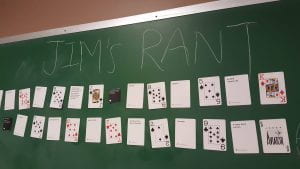

- Translation shown on the board
- Playing cards stuck on the board with blu-tac
- Black cards representing start of a new sentence (added after getting a full stop)
- Playing cards representing “and”, “or”, or “full stop”
- White cards representing nouns that players put on to add to a sentence
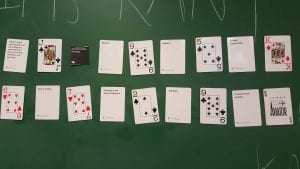
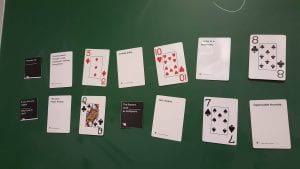
So on the gameplay on Friday, we constructed a short rant with the cards. I think the game went well, people seemed to enjoy it and have a laugh. The overall rant we constructed translates to:
“Trust me I’m, running naked through a mall, pissing and shitting everywhere or a stray pube, and living in a trashcan, and taking a man’s eyes and balls out and putting his eyes where his balls go and then his balls in the eye holes. Bullshit, and GoGurt, or an m16 assault rifle was invented in Nazi Germany. It says here you robbed the black power ranger, why’d you do that? The Romans used Hot cheese, and opposable thumbs, and sperm whales, and cheating in the special olympics, or estrogen and a sassy black woman as toothpaste”.
Improvements
Based on the playtest on Friday, I believe everyone had fun. Gameplay was simple to understand, fun and went pretty smoothly. However, at times people were not sure of what was being put down by other players, hence not really following the overall rant. I think that could be fixed by either reading out loud whenever a new card is placed down on the board, or just have the person read out their own cards that they put down. Furthermore, I feel like that the “or” cards are quite unnecessary as they disrupt the flow of sentences, so for next time I might just make the cards numbered 2-10 as just “and”. Finally, a better way to save time is to have the blu-tac already stuck on to the cards before inviting players to join, rather than just sticking blu-tac on the cards during the game.
Inspiration
My piece was inspired by many of the appropriation examples shown in class. I really liked the idea of physically altering two existing objects and creating something new with those two artefacts. I feel like I can very much reflect my appropriation piece on the Dada movement in Berlin because of many of the political ideologies and social criticisms behind that movement at that time. With my piece, you can actually create sentences that can very heavily criticise certain current political ideologies or social norms which can be rather controversial. So my game is pretty much criticism about all kinds of things. It’s that controversy that my game provides, which really reflects on the movement at that time in Berlin, because the Dada movement in Berlin was criticising the war, the treatment of soldiers with PTSD and soldiers with disabilities etc. m
My piece was also inspired by many of Yoko Ono’s works in the past, such as staging public protests against the Vietnam War, her Cut Piece in 1964 where she confronted issues of class, gender and cultural identity, again, all works of criticism just like my appropriation piece. Finally, I also really liked her Wish Tree piece in 1981, where people were invited to write down a wish and hang the paper on the tree. The tree eventually got filled with wishes, and was sent to the Imagine Peace Tower in Iceland to promote peace. I liked that sentence building aspect of her piece, thus that played a huge part in the inspiration for my piece too.
Overall, my piece can be described as a piece of criticism, that was inspired by many of the political and social works from the Dada movement in Berlin, and also Yoko Ono’s works.
Appropriation of “Heads Up”
Guess

Materials:
- Play cards with pictures of characters
- A dice
How to Play:
Aim: Be the first to guess who is on your card. The clues you give about each other’s character has to be valid and true, however, you can determine how much information you want to give away.
- Shuffle the cards and have all players to pick a card without looking at it
- Roll the dice to see who goes first (highest number goes first in the clockwise direction)
- Roll the dice and pick an action
DICE ROLLS:
- Skip my turn
- Pick someone to act out an action about your character
- Pick someone to make a sound about your character
- Pick someone to say a word about your character
- Ask a yes/no question to the group
- Skip someones turn OR choose options 2-5
Appropriation:
This game was appropriated from the game “Heads Up”. I felt that the game “Heads Up” was too one dimensional and needed more depth to the game. Whenever I saw the game played, the players were very awkward, which meant that there was not enough awkwardness or players were not drawn into the game enough. I appropriated the cards to have only pictures of people and characters like Pickle Rick, Kevin Hart, and Kanye West. This game can be appropriated to accommodate for any types of personalities, accents and topics.
Authors Note:
I chose to create this game because I felt that the game “Heads Up” was way to boring and non-immersive. By adding the dice roll for different actions a new level of difficulty was added. When I play tested this game in class, everyone was enjoying the game. There were multiple comments on how dice roll number 3 was extremely hard.
The Dada movement was a cultivation of multiple cultures and ideas. Art was created by taking created art and distorting it, thereby creating new meanings and ideas. Bringing together popular personalities from movies, tv shows and celebrities was a representation of that idea. I was inspired by the Dada collage we did in class. Given pictures of art during the Dada movement we had to create a collage to represent the Paris Dada movement. Taking that same idea and applying it to the “Heads Up” game, I took a game and reinvented it with the question of how well people know the characters that build up their culture. Incorporating dice rolls into this game brought in a different popular game culture of random generated options and difficulties. The appropriation of adding portraits of popular personalities onto cards was another aspect of creating inspiration for the players to pull from.
In-Class Exercise: Paris Collage

Based on the works of various artists during the Dada movement, specifically in Paris, we put together a collage depicting the Dada movement that was greatly influenced by the literature, theater, and classical music culture thriving in Paris. Dada pieces were created by multiple artists such as Duchamp, Picabia, Dali, Arp, Breton, Man Ray and Tzara. In this Paris collage we decided to go with a theater theme where we had a huge banner and arrows inviting people into the theater.
Appropriate_Final_Iteration_Battle of fighters
Battle of fighters
4 Players
Materials
Two decks of 52 playing cards
Aeroplane Chess
One 6-sided dice
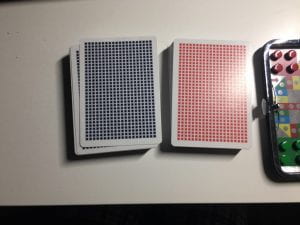

Rules:
Players: Four colors represent four different players. Every player can own 5 planes(fighters) entering the air war. Four colors also matched four suits of playing cards. Red fighter means the heart suit, yellow matches the diamond card, blue is the club suit, and green represents the Spade suit.
Starting: Four players own their own fighters on their bases that match their color, located at the corners of the board at the beginning of game. Each player takes a turn by rolling the dice and according the numbers of dice to draw the same numbers of cards from card pile of game which contains shuffle players cards (104 cards– two decks). Player can follow the rule of cards to use their hands, enter, move, or do other actions for their fighters. Each try to use their fighters to shoot down all other players’ fighters.
When the fighter arrives the flying space that fit fighter’s color, this fighter can jump to the corresponding space.
The plane can hide in its color plane port, but this plane can just stay in the port for three turns.
Every turn for every player, each can just use two cards including common number cards or special skill cards.
Shoot Down: when player A’s fighter lands on another player B’s fighter, B’s plane will be shot down and never enter the game.
The Rule of Using cards: Move of Fighters on the board clockwise around the track, the number of moving spaces indicated by the number of using court. The courts (number card) are just 1 to 10. And J, Q and K only can be used for players make their fighter enter the track and join the battle from the base. Fighters on the base cannot enter the war. If the suit of K matches the color of player’s fighter, this fighter can use the special skill of this suit’s K. Otherwise, K can just be regarded as the card that makes fighter enter the war.
Heart K: Make one plane has one more live. (when this plane was shot down, it can enter its base and enter the war again)
Diamond K: Draw three cards from card pile.
Club K: Choose one number from 5 to 10 as steps to move one fighter on track.
Spade K: Make two fighters enter the war
Limitation: if after starting game 5 minutes, players still do not once send at least one their fighter for entering war, these players will lose, quit the game and other survival players continue the game.
Artist Statement:
Taking advantage of appropriate pieces game to create a new game was the main idea of my game. Not only I used the appropriation on materials and rules of two games, but also combined some cultures of two games. Learning this art of appropriation was in lecture and the first impression of appropriation for me is Dada. Dada represents producing a new art by transferring the readymade arts. My idea was inspired by some ideas from Dada book and lectures.
Zurich Dada shown a kind of freedom feeling in their productions. Because the origin of Dada was launched in here during the World War I. As one neutrality country, many different kinds of refugees escaped to here from the War. Hence, many blends of the cultures prompted the birth of Dada culture. Hence, in my game, I consider the war element, especially for air war. Later, I wanted to combine two cultures together in this game, and I utilized the Chinese Aeroplane chess game and European playing cards to transfer a new game. This new game contains the characteristics of Asian and European elements. Chess represented the historical battles and many subtle strategies used in the chess also shown in the Chinese historical war stories. Playing chess can be regarded as one mock war to develop our thinking ability. Playing cards’ K and Q can be regarded as the European royalty’s King and Queen. Different card represents a variety of status for different people, like social classes of Middle ages in Europe.
For the artwork of Marcel Duchamp, there is one meaningful production, which is the Duchamp Fountain. The Fountain breaks the understanding of art by people. The Fountain was a porcelain urinal, which was submitted for the exhibition of the Society of Independent Artists. This artwork represented Duchamp wanted to challenge the current art in New York and wanted to break the limitation of art. Hence, in my game, I also want to show something I want to break. The rule of cards did not follow the rules of playing cards. Level of cards will not show in my game. The card will not be judged by their values like people in Middle Ages European society judged by their status. I want to break this rule not only for the game, but also for the implication behind different of cards. Every number of cards just means the steps of moving fighter. Any step in some situations can play a decision role in the game. Because sometimes, you need Ace card to move one space and shoot down the enemy fighter closed your fighter. Although the value of the Ace is one, but it also can be more important than K.
In the Zurich Dada chapter, I found most dada artworks were constructed by different components from other different readymade artworks. So, in my game, I use the readymade chess pieces, chess board, dices and cards in playing cards. I did not create some new products in the game and just change some rules and add some new rules to form my new game. I choose the basic rule of Aeroplane chess including four players and move the chess pieces. And I added some new rules: like rolling dice to decide how many cards to draw and use cards to move chess pieces instead of original rule of chess that rolling dice to decide how many steps chess piece should move. Furthermore, the cards will be not judged value by their numbers rather than the game situations.
In conclusion, my game combined the cultures of Asian and European elements, some rules and materials of two games, changing rules of cards represents my ideas that I did not want card like people in society judged by their values or status. Choosing readymade games’ components to form my new game not only for using their materials, but also more important one is creating new concept and understanding to the readymade games.
Artwork #1 Score – Search, Read, Write, and Pass along
Artists Statement:
My Idea for this project was to make a fun game toying with peoples minds and emotions to see how they react to a random sentence and what they would think, act and just, in general, react to what was written in the paper, the point of it was for them to write something down in that paper and pass it along in that amount of certain time, this also took a lot of inspiration from Yoko Ono’s Grapefruit. Also inspired by things that you see written on blogs, Reddit, etc… that are harmful words that affect this society and make it a worse place to live, and since people react harshly to those types of words I was wondering how they would react to what I wrote down in those papers both harmful and not harmful.
This project also represents in many ways social interaction, mostly on the part on how people react to different kinds of emotions being thrown their way, as right now in the current world we live in is mostly ruled over by the form of communication known as texting, this project shows how people react to words that have no emotions attached to them whatsoever and they can choose to take it and reply as is, without knowing if those words might have had a completely different meaning altogether.
This project serves to show also that voice communication is still one of the best ways to express emotions because you might say some type of words but through text, one might not know if you say it jokingly, sarcastically or even serious, through voice and your tone that can be determined way faster. I want this to inspire our generation and the generations that are more forward to us to talk face to face or at least by voice and not to solely rely on texting, notes, or even emails. As talking through voice is a way that can fix several problems that maybe even in the past they might have been taken out of context and maybe it was not even a problem in the beginning.
I hope that in the near future even if it is not through this project that our generation especially recognizes that fact and that it can go back to talking through voice, so that people avoid unnecessary problems, lose friendships cause of reasons that might have never even existed, all just because of a mistranslation of your tone of voice through text.
This project also took very hard inspiration from”The Happening” since what I did was play the part of the director in a scenario that I let unfold just by tossing some paper balls into the crowd and let them make the experience happen right before everyone’s eyes in a very limited amount of time.
Score:
Grab a piece of paper
Write anything
Crumple the paper up
Song is chosen
Throw the paper around
Each person that catches it opens it up and looks for a sentence in 5 seconds.
Look at their reaction
Then they chose to keep that sentence like that, change it, or add another sentence
Another person catches it and keeps it going until the song chosen ends
At the end open up the paper to be able to read what everyone wrote if they wrote anything
Rules:
To pass the paper around you have to throw it
Uncrumple the paper until you find a sentence.
You have the choice to keep it like that, change it or add another sentence close to it
Then crumple it again and throw it randomly around the room
Keep on throwing the paper until the song finishes
If you don’t find a sentence in 5 seconds then add something or crumple it up and throw it again
How It played out:
The game was played out during class with a very low time range as it was supposed to take 5 minutes or more but since the class was about to end I only had a minute, But in that meaning a lot happened, a lot of people wrote interesting things on the paper that many people had different types of impressions out of, and it turned out perfectly, and it showed me that many difrent people react diffrently to difrent words, so everything that I wanted it to show was shown and my point was made.
The second iteration turned out rather interesting since the group was compromised around 5 people I only gave them 1 minute with 2 papers and to be honest I have never seen anyone uncrumple a paper so fast to loo for a sentence and to be honest even with the smaller group and the smaller time frame it turned out very nicely and iteresting as everything still went to plan.
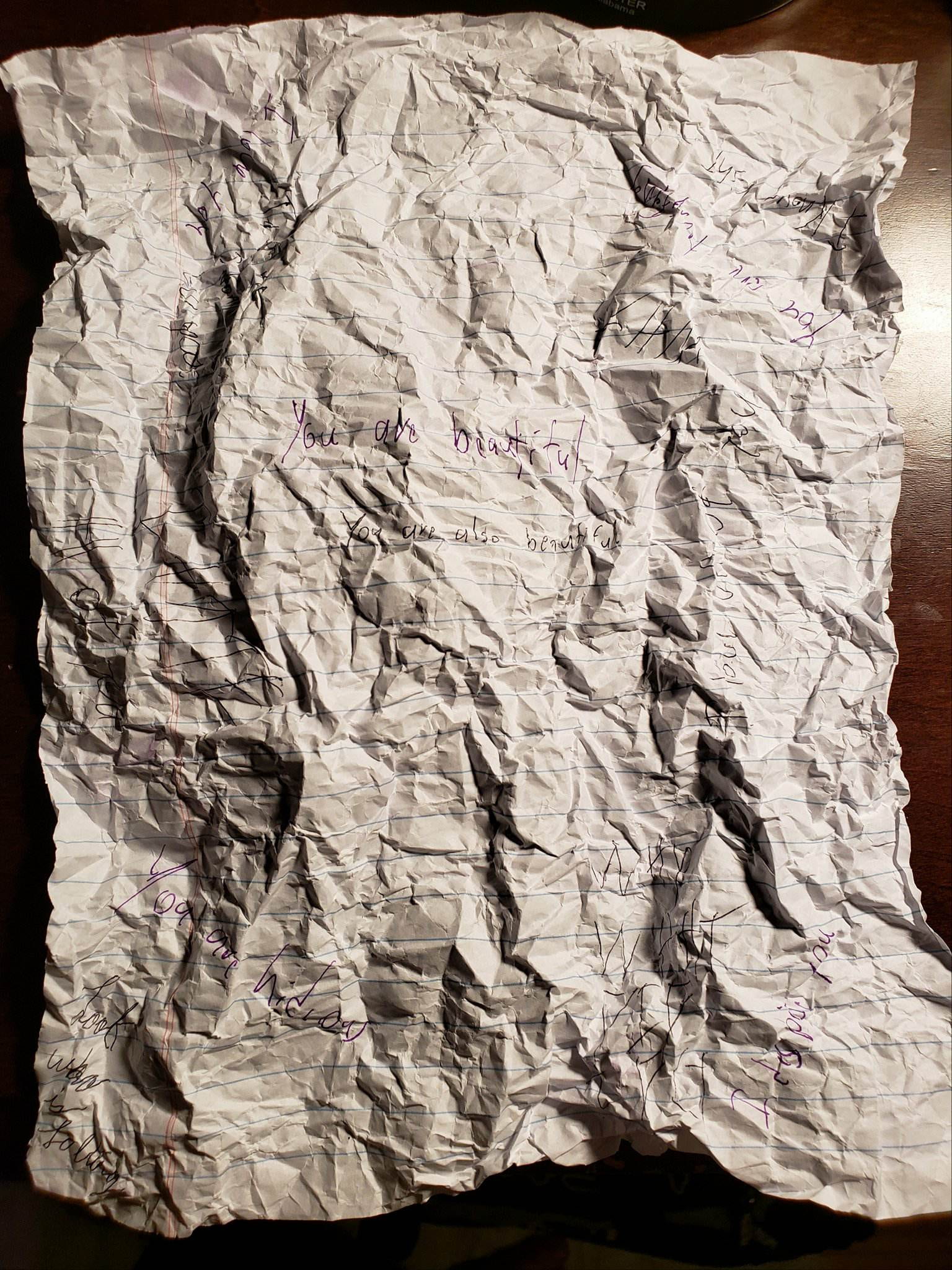
This is picture is the paper that was the result of the experiment.
Appropriation First – Final Iteration: Blind Game
Artists Statement:
The core concept of this project is that you take a single player game and to try to make it a 2 player game by blindfolding that person and taking the sense of eyesight away and having another player guide them by voice as they go through the game. The games that are going to be used are for example platforming games, fighting games, and maybe a 1v1 MOBA mode.
The point of this was to see how you can make a completely new game just by modifying something in real life instead of modifying it inside the game, this experience of taking away one of the players sense makes the game play in a completely different manner and gives the player a new fresh experience on the game, because even though you might have played some of the games presented in the past the way that one of the players has no eyesight but has control and the other one has eyesight but no control gives them almost a whole new type of game that requires teamwork to be able to achieve success which normally never would happen otherwise in the games that were presented. This project was inspired by the Hanover college don in class that it was the mixture of different elements from different places all in one place, in this case, the element is to take away pieces and split them up creating a whole new experience that no one ever expected.
This project was made to portray also that when you have to modify a game to have a different kind of experience to it, it does not always have to be inside the game per say and could be an outside force changing the experience completely. This concept could be implemented and taken to very high levels of inspiration for future game projects as to change a single player game to multiple ones that both players have to depend on each other to do well and be able to succeed, this concept can take a very huge fruition in the game industry and be able to make it into many games and open a whole new genre in the game industry that no one ever expected. This can take fruition in the casual, experimentation, indie, and even in the competitive game market and it is something I hope that I can take with me and try to implement it and move the project forward with time.
This project will be implemented into several categories of games in the near future, Platformers, MOBAS, Fighting, and even horror, both for the new experience and for the fun aspect. I hope this also inspires new game devs into taking into consideration that not everything has to be implemented inside the game but it can be outside the game and even if it has to be with the player.
To point out one extra fact this is also inspired from the reading “Discourse Engines for Art Mods” which discusses the many different ways onto which someone can mod a game both inside and outside the game. And another reading “Sustainable Play: Towards A New Games Movement for the Digital Age” inspired me to make this game to put the seeds into place so that games in the future can take inspiration from this mod and take advantage of it and make it their own into games of the future.
Rules:
- Player 1 can not take off blind fold at any time
- Player 2 can only help with voice, he is not allowed to touch any controls.
How it turned out:
The final iteration turned out just as predicted. The implementation of teamwork in these types of games had a huge shock and made people experience the game in a new way, making them have fun and also happy and laugh as this was very new for everyone that was able to play, it was a very fun twist to single player games and it made the experience something amazing.
The second iteration turned out to be pretty fun to see and experience as I saw the test subjects do their best to work as a team and be able to progress farther than in the first iteration and even in the boss fight they almost even cleared it, the level of fun they had was so much that even they did not want to stop the experiment so for me that brought me great pride as to be able to see that they had so much fun that they did not even want to stop playing.
Dropbox link for videos:
https://www.dropbox.com/s/5371o2ta2z0lnkr/20180526_132843.mp4?dl=0
The first video shows our players trying to conquer one stage in the game that they struggled with through the whole project.
https://www.dropbox.com/s/xohlf8qwo61soiw/20180526_135155.mp4?dl=0
The second video shows the players trying to beat the boss that they were actually very close to beating.

This image shows the test subject from the back being blindfolded to play the game following the other player’s instructions.

This is a shot from the front.

This last one is to show the player un blindfolded trying the game again and to his surprise,e it was completely diffrrent from what he thought.
Appropriation Show and Tell: Shovel Knight OST The Starlit Wilds Remix by Captain Impossible
The type of appropriation that I selected was taking a original game soundtrack (OST) in this case it is Shovel Knight The Starlit Wilds which here is a link to the original version:
Now my roommate Captain Impossible made this remix of it, which can only be classified as beautiful and it shows a perfect example of appropriation since it is taking a song and having fun with it and making it your own here is a link to his song:
https://soundcloud.com/impossiblewilds/starlit-wilds-captain-impossible-flip/s-yuXEV